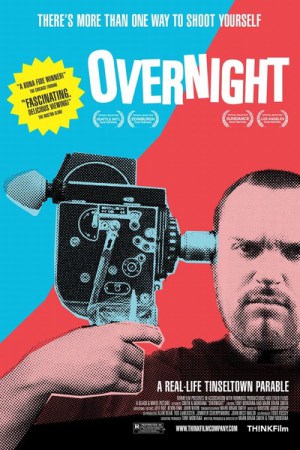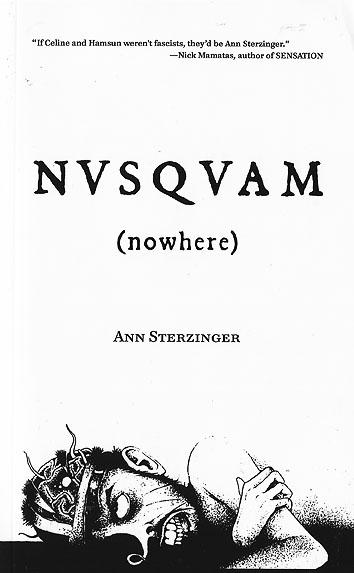 It doesn’t take much rope for some people to hang themselves. “Overnight” is a 2003 documentary about someone who hung himself with six inches of empty air. Troy Duffy was a bartender in LA with a screenplay, and he received an opportunity that hardly ever happens to bartenders in LA with a screenplay – a major production and distribution deal from Harvey Weinstein. Thrilled, he immediately hired a couple of local filmmakers to make a documentary about his assured rise to fame and riches. They ended up capturing a Hindenburg disaster on film.
It doesn’t take much rope for some people to hang themselves. “Overnight” is a 2003 documentary about someone who hung himself with six inches of empty air. Troy Duffy was a bartender in LA with a screenplay, and he received an opportunity that hardly ever happens to bartenders in LA with a screenplay – a major production and distribution deal from Harvey Weinstein. Thrilled, he immediately hired a couple of local filmmakers to make a documentary about his assured rise to fame and riches. They ended up capturing a Hindenburg disaster on film.
When aliens land and ask us for positive reasons why we shouldn’t be assimilated, I don’t there’ll be many fingers pointing at Troy Duffy. Arrogant, belligerent, with a tendency for insulting the big-name actors that he’s supposed to be schmoozing, he’s never made a movie before, and hasn’t even been to film school. He brags about showing up to production meetings hungover and wearing last night’s trousers. He has one talent: malapropism. “We’re a cesspool of creativity!” he exclaims. Elsewhere, he schools a naysayer: “Get used to my film career, ‘cuz it ain’t going anywhere.”
His boorish antics land him on Hollywood’s collective shit-list, and soon he receives a call from Weinstein. His film has been put into dreaded “turnaround” mode, halting production until a new deal can be negotiated. When a new offer to pick up the film emerges, its financing is very, very thin. And when the film is made, nobody wants to distribute it.
Another plot thread involves Duffy’s band, The Brood, who received a label deal to score the soundtrack to his film. His bandmates soon come to suspect that Duffy is not sharing his sudden windfall equally. At first Duffy says they don’t deserve a share of the royalties. Then, he moderates his position. “You do deserve it, but you’re not gonna get it.”
Things go from disaster to disaster, with Duffy’s family, co-producers, and bandmates going along for the ride (it’s not their first time dealing with this guy. You think they suspect there’ll be rubbernecking opportunities aplenty). As his projects steadily burn down, there’s endless scenes of Troy either partying or being a jackass. No doubt he fancies himself a work-hard-play-hard type, like Howard Hughes. But he hasn’t actually achieved anything yet. He’s like a runner who wants the champaign popped at the 900m line.
The documentary is fairly narrow in focus. We don’t see the critical moment where Duffy negotiates the film deal in the first place. And it doesn’t delve into the conspiracy theories about why Weinstein took a chance with Duffy, even if only for a figurative moment. It’s been speculated that he never planned to make Duffy’s film, that The Boondock Saints was destined for turnaround since day one, and it was just a PR stunt for his company. Yank a peasant out of the mud, and put a crown on his head. Then, when the cheering crowds are gone, quietly take it away. We don’t know if this is what happened. It’s certainly about as plausible as Weinstein trusting Duffy with millions of his dollars.
Ironically, Duffy’s film has proven to be massively popular on DVD. Unfortunately, he signed a contract that does not make him party to DVD profits.
 Some books keep you at arms’ length from their characters misery. Ann Sterzinger shoves your nose in it, like you’re a misbehaving dog and the book is your mistake. In one sense, it’s very funny. In another sense, it’s not funny at all. It doesn’t matter who you are. If you’re made of carbon, SOMETHING in this book will hit too close to home.
Some books keep you at arms’ length from their characters misery. Ann Sterzinger shoves your nose in it, like you’re a misbehaving dog and the book is your mistake. In one sense, it’s very funny. In another sense, it’s not funny at all. It doesn’t matter who you are. If you’re made of carbon, SOMETHING in this book will hit too close to home.
Lester Reichertsen was a punk rock musician until his band kicked him out, seemingly on the verge of their big break. Now he’s living a fairly typical death in the world of academia. His dissertation is proving as painful as root canal surgery. He works as a put upon TA at the local college. He almost hates his son. He’s not drifting away from his wife, but only because they were probably never close to begin with. He is alienated from everyone, including himself. In short, he is a human anchor, plumbing the depths of the middle class by colliding with the bottom head-first. He’s a Holden Caulfield grown old enough to see himself become one of the phoneys.
The book is a succession of partly comic, partly ghastly events that illustrate the emptiness of his life. Encounters with his father and his father-in-law, unreconstructed narcissists both. A run-in with his old band. A young woman who might be the Lolita to his Humbert Humbert. All of it serves to reaffirm that he’s not insane, he’s just stuck in an insane world. How does he function? Is there ANY way to function? As you approach the end of Nvsqvam, it’s with a growing sense of apprehension, as though the thinning sheaf of pages is a ticking bomb. There can’t possibly be an escape for Lester.
The book is intense and grim, but it’s funny, too. Sterzinger induces cringe-laughter so frequently that I think my neural pathways have been trained to never again do one without the other. Like A Confederacy of Dunces (a book this sometimes reminds me of) Nvsqvam‘s characters seem stylised and exaggerated without seeming fake. This is another one of those books where you’ll meet every jerk you’ve ever known in its pages, if you’re not careful.
It also has an interesting metafictional angle, similar to Will Self’s The Book of Dave (although Sterzinger doesn’t go as far with the concept). It’s written in a way that invokes an classical document, filled with footnotes to help explain 21st century culture to some far-future student. At first, these footnotes seemed distracting. But they’re hilarious, and soon one looks forward to them – it’s like the book just proffered you a hors d’ourve. And I liked the way the events of Lester’s life become intertwined with the classical text he’s writing his dissertation on.
As the book progresses, the early gathering of stormclouds builds to a cat-5 gale. Nvsqvam is an exhausting book, and reading in small passages is recommended and perhaps necessary.
But it’s honest, and that makes it all the more painful. The publisher printed the title of the book at the top of every page – in an eerie way, this almost seems to become part of the text. Occasionally, Lester has small reversals of fortune. Sometimes, there’s a ray of hope. But your false hope is crushed anew every time you turn the page by a reminder that no matter what’s happening, you’re still Nowhere.
 In the Miso Soup has been called many things, most of them not true. You’ll hear it called, over and over, “The Japanese [Something]”. The Japanese Silence of the Lambs. The Japanese American Psycho (hey, I can grok it). Et cetera. None hit really close to the truth, which is fitting, because the novel’s about looking the other way, and deliberately missing the point.
In the Miso Soup has been called many things, most of them not true. You’ll hear it called, over and over, “The Japanese [Something]”. The Japanese Silence of the Lambs. The Japanese American Psycho (hey, I can grok it). Et cetera. None hit really close to the truth, which is fitting, because the novel’s about looking the other way, and deliberately missing the point.
The story isn’t much. It’s barely even a story. Kenji is a sex tourism guide for thrill-seeking gaijin, and he ends up working for a genuinely odd duck called Frank, an American who claims to be missing a section of his brain, and who might just be the serial killer stalking Shinjuku. Kenji and the rest of the story’s characters (including his girlfriend Jun) struggle to be two dimensional, and mostly exist as sounding boards and emotional foils for Frank, who carries the bulk of the story.
Frank’s a kind of prism through which we see the various contradictory aspects of Japanese society. Prudish, conservative…but you’d never see groups of schoolgirls selling sex to middle aged men in the United States. The idea that Japan embodies “too much, yet too little” has been done before, but Murakami bulldozes it into your head. Frank’s behavior seems abhorrent, but it doesn’t seem implausible that he’d go to Japan to commit these acts, rather than another country. Frank and Japan seem to fit together, in a weird way.
In the Miso Soup plays pretty loose ball with conventions on how to structure a novel. The big climax hits exactly halfway through, and much of the rest of novel is spent in incessant talkiness. Western gore porn novels make a mess and then fade to black. This novel deigns to show the emotional clean-up process afterwards, as well. There’s long periods of didacticism: at a certain point comparisons to Sade seem apt, as Murakami virtually forgets he’s telling a story and just directly reads you the riot act on some philosophical ideas for a page or two.
But the ideas are all compelling and heartfelt ones. Like the more famous Murakami, sometimes you can’t discern what his exact point is, but you can tell there always is one.
Props are due to translator Ralph F. McCarthy, who avoids the tin-eared “upmarket Babelfish” tone Japanese to English novels can sometimes have, and makes the prose eerie, uneasy, and alive. In his hands, Murakami’s version Shinjuku becomes a neon-lit abattoir that disturbs, unsettles, and most of all, convinces. Sometimes Japanese novels hold English readers at arms length because of the translation. Here, it doesn’t, no matter how much you might wish it so.
It’s not especially similar to any Western novel I can recall reading. At certain points, it’s even hard to tell if you’re having a good time. But if you want a compelling journey through the grease-traps of Japanese society, Murakami’s work is very thick soup indeed.
 It doesn’t take much rope for some people to hang themselves. “Overnight” is a 2003 documentary about someone who hung himself with six inches of empty air. Troy Duffy was a bartender in LA with a screenplay, and he received an opportunity that hardly ever happens to bartenders in LA with a screenplay – a major production and distribution deal from Harvey Weinstein. Thrilled, he immediately hired a couple of local filmmakers to make a documentary about his assured rise to fame and riches. They ended up capturing a Hindenburg disaster on film.
It doesn’t take much rope for some people to hang themselves. “Overnight” is a 2003 documentary about someone who hung himself with six inches of empty air. Troy Duffy was a bartender in LA with a screenplay, and he received an opportunity that hardly ever happens to bartenders in LA with a screenplay – a major production and distribution deal from Harvey Weinstein. Thrilled, he immediately hired a couple of local filmmakers to make a documentary about his assured rise to fame and riches. They ended up capturing a Hindenburg disaster on film.

